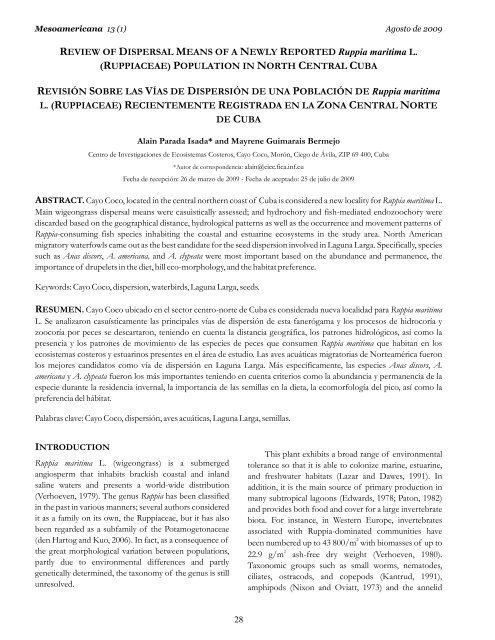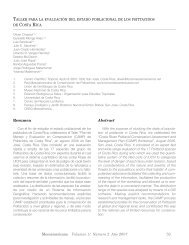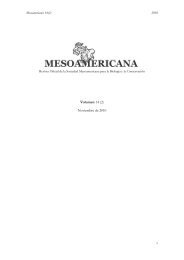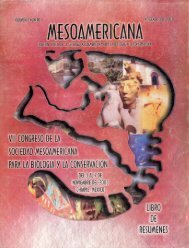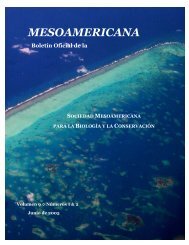MESOAMERICANA - Sociedad Mesoamericana para la BiologÃa y la ...
MESOAMERICANA - Sociedad Mesoamericana para la BiologÃa y la ...
MESOAMERICANA - Sociedad Mesoamericana para la BiologÃa y la ...
Create successful ePaper yourself
Turn your PDF publications into a flip-book with our unique Google optimized e-Paper software.
<strong>Mesoamericana</strong> 13 (1) Agosto de 2009<br />
REVIEW OF DISPERSAL MEANS OF A NEWLY REPORTED Ruppia maritima L.<br />
(RUPPIACEAE) POPULATION IN NORTH CENTRAL CUBA<br />
REVISIÓN SOBRE LAS VÍAS DE DISPERSIÓN DE UNA POBLACIÓN DE Ruppia maritima<br />
L. (RUPPIACEAE) RECIENTEMENTE REGISTRADA EN LA ZONA CENTRAL NORTE<br />
DE CUBA<br />
A<strong>la</strong>in Parada Isada* and Mayrene Guimarais Bermejo<br />
Centro de Investigaciones de Ecosistemas Costeros, Cayo Coco, Morón, Ciego de Ávi<strong>la</strong>, ZIP 69 400, Cuba<br />
*Autor de correspondencia: a<strong>la</strong>in@ciec.fica.inf.cu<br />
Fecha de recepción: 26 de marzo de 2009 - Fecha de aceptado: 25 de julio de 2009<br />
ABSTRACT. Cayo Coco, located in the central northern coast of Cuba is considered a new locality for Ruppia maritima L.<br />
Main wigeongrass dispersal means were casuistically assessed; and hydrochory and fish-mediated endozoochory were<br />
discarded based on the geographical distance, hydrological patterns as well as the occurrence and movement patterns of<br />
Ruppia-consuming fish species inhabiting the coastal and estuarine ecosystems in the study area. North American<br />
migratory waterfowls came out as the best candidate for the seed dispersion involved in Laguna Larga. Specifically, species<br />
such as Anas discors, A. americana, and A. clypeata were most important based on the abundance and permanence, the<br />
importance of drupelets in the diet, bill eco-morphology, and the habitat preference.<br />
Keywords: Cayo Coco, dispersion, waterbirds, Laguna Larga, seeds.<br />
RESUMEN. Cayo Coco ubicado en el sector centro-norte de Cuba es considerada nueva localidad <strong>para</strong> Ruppia maritima<br />
L. Se analizaron casuísticamente <strong>la</strong>s principales vías de dispersión de esta fanerógama y los procesos de hidrocoría y<br />
zoocoría por peces se descartaron, teniendo en cuenta <strong>la</strong> distancia geográfica, los patrones hidrológicos, así como <strong>la</strong><br />
presencia y los patrones de movimiento de <strong>la</strong>s especies de peces que consumen Ruppia maritima que habitan en los<br />
ecosistemas costeros y estuarinos presentes en el área de estudio. Las aves acuáticas migratorias de Norteamérica fueron<br />
los mejores candidatos como vía de dispersión en Laguna Larga. Más específicamente, <strong>la</strong>s especies Anas discors, A.<br />
americana y A. clypeata fueron los más importantes teniendo en cuenta criterios como <strong>la</strong> abundancia y permanencia de <strong>la</strong><br />
especie durante <strong>la</strong> residencia invernal, <strong>la</strong> importancia de <strong>la</strong>s semil<strong>la</strong>s en <strong>la</strong> dieta, <strong>la</strong> ecomorfología del pico, así como <strong>la</strong><br />
preferencia del hábitat.<br />
Pa<strong>la</strong>bras c<strong>la</strong>ve: Cayo Coco, dispersión, aves acuáticas, Laguna Larga, semil<strong>la</strong>s.<br />
INTRODUCTION<br />
Ruppia maritima L. (wigeongrass) is a submerged<br />
angiosperm that inhabits brackish coastal and in<strong>la</strong>nd<br />
saline waters and presents a world-wide distribution<br />
(Verhoeven, 1979). The genus Ruppia has been c<strong>la</strong>ssified<br />
in the past in various manners; several authors considered<br />
it as a family on its own, the Ruppiaceae, but it has also<br />
been regarded as a subfamily of the Potamogetonaceae<br />
(den Hartog and Kuo, 2006). In fact, as a consequence of<br />
the great morphological variation between popu<strong>la</strong>tions,<br />
partly due to environmental differences and partly<br />
genetically determined, the taxonomy of the genus is still<br />
unresolved.<br />
28<br />
This p<strong>la</strong>nt exhibits a broad range of environmental<br />
tolerance so that it is able to colonize marine, estuarine,<br />
and freshwater habitats (Lazar and Dawes, 1991). In<br />
addition, it is the main source of primary production in<br />
many subtropical <strong>la</strong>goons (Edwards, 1978; Paton, 1982)<br />
and provides both food and cover for a <strong>la</strong>rge invertebrate<br />
biota. For instance, in Western Europe, invertebrates<br />
associated with Ruppia-dominated communities have<br />
2<br />
been numbered up to 43 800/m with biomasses of up to<br />
2<br />
22.9 g/m ash-free dry weight (Verhoeven, 1980).<br />
Taxonomic groups such as small worms, nematodes,<br />
ciliates, ostracods, and copepods (Kantrud, 1991),<br />
amphipods (Nixon and Oviatt, 1973) and the annelid


